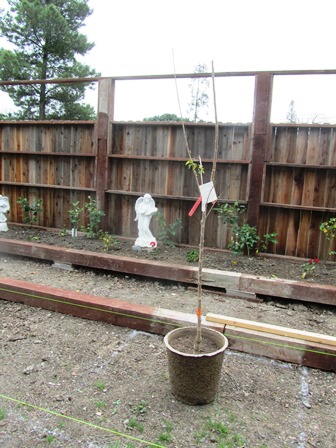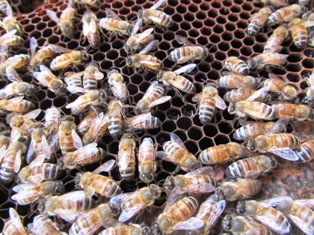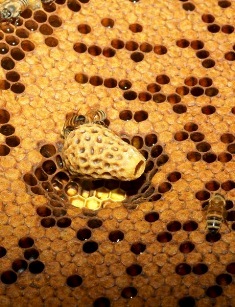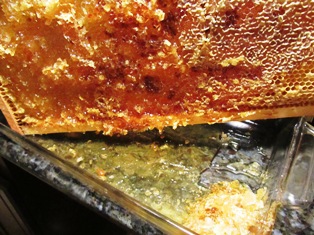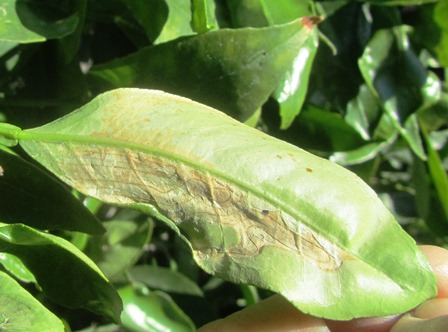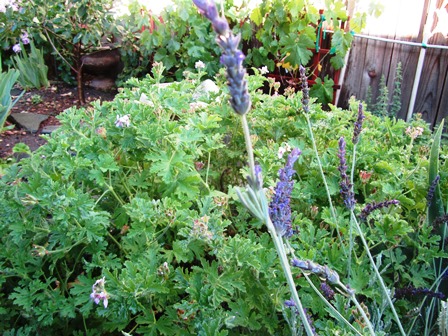Blog Archives
The Start of Something Wonderful . . . Spring!
I jumped at the chance to visit my favorite nursery this past weekend after my husband suggested a drive to Livermore, California. Alden Lane Nursery occupies a beautiful setting amid ancient oaks and there is even a honeybee hive on the premises. Wisteria blooms in perfusion there this time of year.
We came away with some pepper plants, two smoke trees, and four cherry trees, including Bing and Black Tartarian, its pollinator.
We are going to plant the cherry trees at the front of our property and the smoke trees will go in that area as well. We’ve done very little landscaping on the front of our land, preferring to get the trees and gardens in at the back near our hives and chicken run.
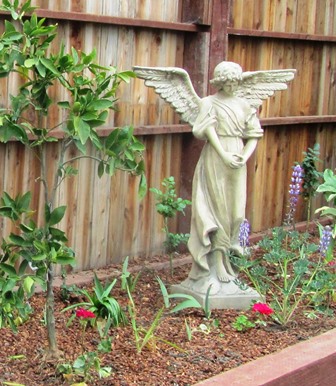
The beds that run the length of the fencing at the front of the farmette feature statuary, citrus, and bedding plants
Everywhere you look on the farmette, there are projects to be done. We chip away at them when we can. My husband works days and I write my novels, so the work will undoubtedly be never-ending. But that’s okay. We aren’t in a hurry and it’s easier to just live by the cycles and seasons of nature.
When I think of how the peaches and apricots are forming and the bees are almost ready to swarm, I know spring is here. And it’s my favorite season, so I’ll go outside, ignore the projects, have a cup of tea, and enjoy the start of something wonderful!
Time to Open the Hives, Check on the Bees
My honeybees have become surprisingly active for the dead of winter. Local forecasters tell us that the Bay Area temperatures may reach 80 degrees Fahrenheit by the end of the week. My apple and early peaches won’t wait; they’ve already blossomed.
The warm weather, time of year together with the fact that almond trees will be blooming in a couple of weeks and the lavender around my farmette is already blooming tells me I have to open the hives. My beekeeper neighbor says that his bees are already out collecting pollen–lots of it–and that means we have to get to work.
The hives have to be checked now for mold (that long period of hard rain in December caused some of my neighbor’s frames to mold). Moldy frames can’t be renewed; they have to be tossed. Honeybees can get nosema (with diarrhea), which shows up as spots at the base of the hive.
The bees are finding flowers on their forage runs and are returning to the hive laden with pollen.
Bee queens will be busy laying eggs in the coming weeks, if they aren’t already. This is the time for beekeepers to purchase new queens. By the first week in April, it’s possible we could see swarming.
So here’s the plan. If the hives have a lot of honey, I’ll harvest some. Strange to be doing that in winter, but the hive will need space for brood. I’ll have to remove frames of honey and insert empty frames with wax (put in the freezer first for a period to kill any pest they might be harboring over).
I’ll put bee food patties in the open hives, so they’ll have plenty to eat (once I take some of their honey). My beekeeper neighbor tells me this will get the hive “heated up” for the queen to do what she does best–lay the eggs.
With so much activity, I’m confident that everything will turn out well, but you never know until you’ve inspected the interior of the hive and checked out everything, including the possibility of mold or the presence of pests or illness.
Mother Nature didn’t ask me, but I would have preferred she wait another month before removing her winter robes and dressing in spring florals. It just seems like now everything to do with the hives is on fast forward!
Spate of Warm Weather Brings Out Early Blosssoms
While schools across the nation are taking snow days because of frigid temperatures, the fruit trees on my Bay Area farmette are showing signs of bud swelling and early blossoming because of a winter heat wave.
Cities around the San Francisco Bay are experiencing early January temperatures of 70-plus degrees Fahrenheit, breaking weather records in some areas. Mother Nature certainly behaves strangely at times.
My five-variety apple tree and the early Desert Gold peach trees are covered with buds that are already showing color. I haven’t as yet gotten around to the winter pruning and spraying with organic oil. Maybe if there’s no wind today, I’ll squeeze that chore in with the others.
I did cut back the Washington navel orange that is infected with Leaf Miner, a pest that’s crossed the United States from Florida. It attacks new leaves, so I’m thinking if I prune and spray now before spring is in full swing, maybe I won’t lose this tree. Curiously, the pest hasn’t widely infected my blood orange trees but there are signs of it in the leaves of our Satsuma seedless tangerines.
Elsewhere, I’ve done deep digging in the chicken run and added some wood chips and leaf material for compost.
The tea roses have been pruned back to 12 to 18 inches and old canes removed. I’m torn between wanting to add more roses in the beds in front of the bamboo plants on the east/west axis of our property or adding more lavender and sunflowers, favored by the bees.
Tomorrow, I’ll open and inspect my bee hives. I left honey stores this past autumn instead of harvesting. But if the bees have gone through all the honey, then I’ll have to add bee food until we get the first early bulb blooms and wildflowers. The French perfume lavender that the bees love is about the only bloom (bee food) in the garden now. Luckily, I planted a lot of it.
The farm chores don’t just seem endless, they are. But whether the work is daily, weekly, or seasonal, there’s something deeply rewarding–even magical–about living close to the earth in harmony with cycles of seasons and the rhythms of nature. But I admit, it is a little strange to have such warm weather when winter has only just started.
Growing Peaches in Northern California
What could be more sublime that eating a juicy, ripe peach freshly plucked from the tree? If you have space in your Northern California backyard or garden, consider planting one or more peach trees.
In the Bay Area, peaches are fairly easy to grow. Depending on the cultivar, they are heavy bearing. We planted a classic gold Elberta and some early-bearing Desert Gold peaches two years ago. Already, both trees are loaded with peaches.
I ate a Desert Gold peach off the tree today. It was ripe on one side and still a little crunchy on the other. Another week, and they’ll all be ready for a cobbler. The Elberta peaches will not be ripe until late July or early August.
Peaches are best eaten fresh, in my opinion. But they also freeze well or you can make them into jam, preserve them with spices, or blend up a batch of chutney or baby food. Your best bet is to plant peach trees during bare root season because they are cheaper and more plentiful then. Right now (second week of May), nurseries have replanted their bare root trees into pots.
One of my favorite nurseries in the Bay Area is Alden Lane Nursery in Livermore, California. The nursery carries hundreds of fruit and nut trees and thousands of roses. The oak trees on the property are 300 years old and one has a community of honeybees dwelling in the tree. It’s a great time to visit the nursery. For a list of offers, see http://www.aldenlane.com/media/softprogram.pdf.
Peaches need a lot of sunshine, high nitrogen fertilizer, and water to perform optimally. They also suffer from peach leaf curl, a fungus that can be easily treated with a fixed-copper spray. Dormant oil will control scale if they get it. The trees will live for 15 to 20 years.
Prolific producers, peaches need fruit thinning early on to yield larger fruit and avoid branch breakage. See the University of California’s Master Gardener program tip sheet for more information at http://homeorchard.ucanr.edu/Fruits_&_Nuts/Peach/.
If you love peaches, it’s not too late to plant a tree in your backyard for a bountiful crop of late spring/summer fruit.
Nuts and Honey Add Lovely Flavor to Dried Fruit Tart
Flaky tarts piled high with fresh organic berries has always been for me a delightful way to end a summer meal. With the onset of winter now only eleven days away, I flip through my recipe files for something similar to those lovely summer tarts and hit upon an easy-to-make tart filled with dried fruits, nuts, and honey.
You can substitute or add other dried fruit (cranberries, figs, dates, and raisins, for example) to this tart, but I’ve found the best flavor comes from the dried peaches and apricots. They combine beautifully to create a richly flavorful dessert. A dollop of whipping cream on top adds a layer of decadence to this rich autumn tart.
Pastry Ingredients:
1 1/4 cup flour
1/4 cup sugar
1/2 cup unsalted butter (cut into pats or small pieces)
pinch of salt
1 large egg yolk
Directions for Pastry:
Combine pastry ingredients in a food processor with metal blade. Process until the mixture becomes a fine crumble. Add egg yolk and process into dough. Pastry should hold together, forming a ball.
Filling Ingredients:
3/4 cup white dessert wine
3/4 cup honey
18-20 dried apricots and/or peaches
1/2 teaspoon grated orange rind
1 cup blanched whole almonds
3 eggs
1 teaspoon good quality vanilla
2 Tablespoons unsalted butter
1 cup walnuts
Topping:
1 cup cream
1/4 teaspoon cinnamon
1 teaspoon of sugar
Directions for Toasted Almonds:
Preheat oven to 350 degrees Farenheit.
Toast blanched almonds on a baking sheet for 10 minutes. Remove and set aside. Keep oven on for baking the tart.
Directions for Tart Filling:
In a stainless steel pan, add the dried fruit with the orange rind.
Pour over the fruit and rind half the wine and 2 Tablespoons of honey.
Cook over low heat for 20 to 25 minutes until the fruit absorbs the liquid and plumps up, becoming soft and plaint.
In a bowl, combine eggs, honey, remaining wine, vanilla, and butter.
Beat in the walnuts and almonds.
In a springform pan, press the dough as thinly as possible over the bottom and up the sides of the pan. Drop the fruit onto the dough, spreading around over the bottom of the pastry. Pour in the nuts and egg mixture. Use a spatula to smooth the filling.
Bake the tart for 45 minutes on the middle rack of the oven.
Allow the tart to cool in its pan before removing and placing on a serving plate.
Whip cream until peaks form and fold in cinnamon and sugar. Put a dollop on top of each individual serving.
Serves 8.
 Facebook
Facebook Goodreads
Goodreads LinkedIn
LinkedIn Meera Lester
Meera Lester Twitter
Twitter







